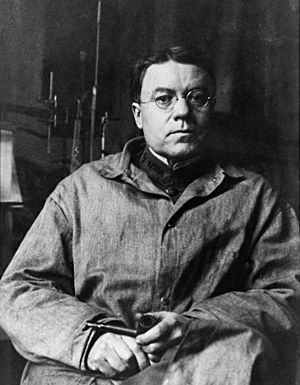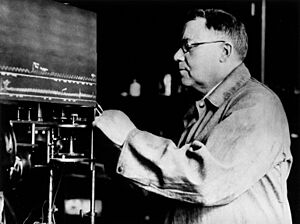Walter Bradford Cannon facts for kids
Quick facts for kids
Walter Bradford Cannon
|
|
|---|---|
 |
|
| Born | October 19, 1871 |
| Died | October 1, 1945 (aged 73) |
| Nationality | American |
| Education | Harvard College (1896) Harvard Medical School (1900, M.D.) |
| Known for | Homeostasis Fight or flight X-ray experiments Cannon–Bard theory Voodoo death |
| Spouse(s) | Cornelia James Cannon |
| Awards | Fellow of the Royal Society, Member of the National Academy of Sciences USA, Member of National Academy of Sciences, USSR |
| Scientific career | |
| Fields | Physiology |
| Institutions | Harvard Medical School |
Walter Bradford Cannon (born October 19, 1871 – died October 1, 1945) was an American physiologist. A physiologist is a scientist who studies how living things work. He was a professor at Harvard Medical School.
Cannon is famous for two main ideas. He came up with the term "fight or flight response". This describes how our bodies react to danger. He also developed the idea of homeostasis. This is how our bodies keep things stable inside. He wrote about these ideas in his popular book, The Wisdom of the Body, first published in 1932.
Contents
Walter Cannon's Life and Career
Walter Cannon was born in Prairie du Chien, Wisconsin. This was on October 19, 1871. His parents were Colbert Hanchett Cannon and Wilma Denio. His sister, Ida Maud Cannon, became a well-known social worker.
Cannon was a very curious person. He loved to read and learn. His high school teacher, Mary Jeannette Newson, was a great mentor to him. She helped him get into Harvard University in 1892.
Education and Early Research
After finishing college in 1896, Cannon went to Harvard Medical School. He started using new x-rays to study how digestion works. He worked with Henry P. Bowditch. In 1900, he earned his medical degree.
After medical school, Harvard hired Cannon as an instructor. He continued his research on digestion. In 1902, he became an assistant professor. In 1906, he became the head of the Physiology Department at Harvard Medical School. He held this position until 1942.
Family Life
Walter Cannon was married to Cornelia James Cannon. She was a successful author. They had five children together. Their son, Dr. Bradford Cannon, became a military plastic surgeon. Their daughter, Marian Cannon Schlesinger, became a painter and author.
In 1901, Walter and Cornelia were the first people to climb the southwest peak of Goat Mountain in Montana. This area is now part of Glacier National Park. The peak was later named Mount Cannon after them.
Views and Beliefs
Cannon believed that the body and mind work together. He thought that understanding how our bodies work could help people live better lives. He also supported using animals in scientific experiments. He wrote a booklet in 1911 to explain why this research was important.
Walter Cannon passed away on October 1, 1945, in Franklin, New Hampshire.
Walter Cannon's Scientific Work
Walter Cannon began his science career in 1892. He started his research in the physiology lab at Harvard. He used the newly discovered x-rays to study how we swallow. He also looked at how the stomach moves food.
In his first experiments, he watched a button move down a dog's throat using x-rays. He noticed that when the dog was stressed, its stomach stopped moving. When the dog calmed down, the stomach started moving again. This made him think about how emotions affect the body.
Cannon published his first paper on this research in 1898. In 1945, he looked back at his career. He said he focused on different things at different ages:
- Ages 26–40: Studying digestion.
- Ages 40–46: Looking at how emotions affect the body.
- Ages 46–51: Researching wound shock during World War I.
- Ages 51–59: Studying how the body stays stable (homeostasis).
- Ages 59–68: Researching how nerves send messages using chemicals.
Key Discoveries and Ideas
Using Metals in X-Rays
Cannon was one of the first scientists to mix salts of heavy metals with food. These included bismuth and barium sulfate. This made x-ray images of the digestive system much clearer. Today, doctors still use a "barium meal" for similar tests.
The Fight or Flight Response
In 1915, Cannon came up with the term "fight or flight". He used it to describe how animals (including humans) react to danger. He wrote about this in his book Bodily Changes in Pain, Hunger, Fear and Rage.
He explained that when we face a threat, our bodies release a hormone called adrenaline. Adrenaline helps us get ready to either fight the danger or run away from it. For example, adrenaline makes blood vessels in our limbs relax. This sends more blood to our muscles. It also makes blood vessels in our skin tighten, which helps stop bleeding if we get hurt. Adrenaline also releases sugar into our blood for quick energy.
Understanding Wound Shock
During World War I, Cannon was a military doctor. He found that the blood of soldiers in shock was acidic. He suggested giving them sodium bicarbonate to balance the acid. This helped treat the shock.
The Concept of Homeostasis
Cannon developed the idea of homeostasis. This is the body's ability to keep its internal conditions stable. He explained this in his book The Wisdom of the Body.
He described four main points about homeostasis:
- Our bodies need ways to stay stable, like keeping a steady temperature.
- If something tries to change the body's balance, there are ways to resist that change. For example, if your blood sugar goes up, you might feel thirsty to help dilute it.
- Many different systems work together to keep the body stable. Blood sugar is controlled by hormones like insulin.
- Homeostasis doesn't happen by accident. It's a result of the body's organized systems working together.
The Sympathoadrenal System
Cannon also suggested that the sympathetic nervous system and the adrenal gland work together. He believed they act as one unit to help the body in emergencies. He thought they both used the same chemical messenger, adrenaline. This idea of a "unitary sympathoadrenal system" is still important today.
Cannon-Bard Theory
With another physiologist, Philip Bard, Cannon developed the Cannon-Bard theory. This theory tries to explain how we experience emotions. It suggests that we feel an emotion and have a physical reaction at the same time.
Dry Mouth Hypothesis
Cannon also proposed the Dry Mouth Hypothesis. This idea suggested that people feel thirsty because their mouths get dry. He did an experiment with dogs to test this. He showed that even if water didn't reach their stomachs, they would still drink the same amount. This suggested that the feeling of thirst was linked to the mouth, not just the stomach.
Publications
Walter Cannon wrote many important books and articles:
- 1910, A Laboratory Course in Physiology
- 1911, The Mechanical Factors of Digestion
- 1915, Bodily Changes in Pain, Hunger, Fear and Rage
- 1923, Traumatic Shock
- 1932, The Wisdom of the Body
- 1937, Digestion and Health
- 1945, The Way of an Investigator: a scientist's experiences in medical research
Images for kids
See also
 In Spanish: Walter Cannon para niños
In Spanish: Walter Cannon para niños




